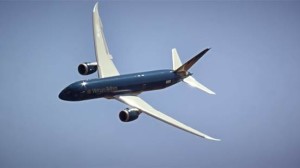Cessna Grand Caravan EX special mission demonstrator makes Paris debut
June 15, 2015
PARIS, France (June 15, 2015) – Cessna Aircraft Company, a subsidiary of Textron Aviation Inc., a Textron Inc. (NYSE:TXT) company, will debut a newly-configured Cessna Grand Caravan EX demonstrator at this week’s Paris Airshow. The aircraft features a variety of special mission applications, such as a surveillance console and a medical stretcher, as well as a variety of cabin and seating configurations, including newly designed light-weight production seats in a half club configuration and a stowable utility seat.
“With a high percentage of our Caravan sales going into special mission roles around the world, this platform has proven to be a truly versatile multi-tasker,” said Dan Keady, vice president, Special Missions. “Having a fully equipped special missions Grand Caravan EX demonstrator in the market allows our customers to experience firsthand the extensive range of capabilities available on this platform.”
The Grand Caravan EX is particularly well suited for a wide array of operations due to its spacious cabin, high useful load of more than 3,500 lbs. (1,588 kg), large cargo door and the ability to operate from short, unimproved surfaces. These aircraft have proven to be successful in a variety of special mission applications, including aerial survey, air ambulance, paratrooper, amphibious operations, surveillance, training and utility/transport. The Grand Caravan EX can also be manufactured with structural provisions for two hard points on each wing, allowing the aircraft to be configured for missions that require armament.
The demonstrator aircraft is making its global debut through the year with appearances scheduled in Europe, the Caribbean, Latin America, Middle East, Africa and Asia Pacific.
Beechcraft delivers four T-6 military training aircraft to United States Army
June 15, 2015
PARIS, France (June 15, 2015) – Beechcraft Defense Company LLC, a Textron Inc. (NYSE:TXT) company, today announced at the Paris Airshow that it recently delivered four Beechcraft T-6D military aircraft to the United States Army. These aircraft, which are part of the Joint Primary Aircraft Training Systems (JPATS) program, will be stationed at Redstone Arsenal in Huntsville, Alabama, and will replace the Beechcraft T-34 aircraft currently in use at the facility.
“We are pleased that the U.S. Army is joining the U.S. Air Force, U.S. Navy and countries around the world in trusting the T-6 to prepare and support their combat flying forces,” said Russ Bartlett, president, Beechcraft Defense Company. “This versatile platform comprised of four aircraft will be used in a variety of training and mission support applications.”
Upon arrival in Huntsville, the four T-6D aircraft will perform such missions as: Operational Support Airlift, utility, training, chase, airspeed calibration support, cloud physics research, and stores component research and qualification.
About the T-6D
The Beechcraft T-6D is a hybrid of the T-6B and T-6C trainers. It features new standard avionics, featuring integrated mission computers, up-front control panels, multi-function displays and a Heads-Up Display. The Army T-6D aircraft have a hard point wing to allow carriage of up to six wing-mounted pylons and two external fuel tanks.
Strength of the T-6 platform
The Beechcraft T-6 delivers world-class training capability and is ideally suited for teaching the most basic introductory flight training tasks through the more challenging and complex advanced training missions that could previously only be accomplished in far more expensive jet aircraft. The T-6 is being used in more than 20 countries around the world to train pilots, navigators, and weapons systems operators. To date, Beechcraft has delivered more than 850 T-6 trainers, which have amassed more than 2.5 million flight hours.
Aerocardal Selected as Authorised Service Centre for Pilatus PC-12 Aircraft in Chile
June 15, 2015
As Pilatus Aircraft Ltd’s sales and service presence expands around the globe, the ability to provide top quality maintenance from any location is essential. To meet this criterion, Aerocardal in Santiago, Chile has been appointed as a new addition to Pilatus’ growing list of authorised service providers for the PC-12.
“The exceptional commitment to high quality service displayed by Aerocardal makes them a welcome addition to Pilatus’ group of service centres,” explains Pete Wolak, Vice President of Customer Service for Pilatus Business Aircraft Ltd.
“Over 20 years of service in the region demonstrates the success of Aerocardal’s customer-focused business model. Their approach to the highest level of service is completely aligned with Pilatus’ own core values, so we see this as a perfect fit. It is a relationship that will benefit Pilatus customers in Chile and surrounding countries”, adds Pete Wolak.
Founded in 1996, Aerocardal was the first FBO in Chile. Since then it has established itself as a highly qualified leader in the Chilean business aviation industry. The company’s main base is located at Santiago International Airport, where the Aerocardal FBO provides full services with a VIP lounge, ramp space of 10,000 square metres, and their own fuel service facility with 120,000 liters capacity. Aerocardal earned ISO 9001 certification for its operations in 2008.
Gulfstream G280 Adds Another Speed Record To Books
June 15, 2015
SAVANNAH, Georgia, June 15, 2015 — Gulfstream Aerospace Corp. today announced that the Gulfstream G280 recently added to its growing list of city-pair records, this time linking Paris with Abu Dhabi.
On April 24, the super mid-sized aircraft traveled from Paris-Le Bourget Airport to Abu Dhabi International Airport in United Arab Emirates. The distance of 2,908 nautical miles/5,386 kilometers was covered in 6 hours and 16 minutes at an average speed of Mach 0.82.
Pending approval by the U.S. National Aeronautic Association, the G280’s 51st city-pair mark will be sent to the Fédération Aéronautique Internationale in Switzerland for consideration as a world record.
“It’s a testament to the G280’s many attributes that we’ve delivered more than 60 of these aircraft to operators in 11 countries,” said Scott Neal, senior vice president, Worldwide Sales and Marketing, Gulfstream. “The G280 had the best range, speed, fuel efficiency and cabin comfort in its class when it entered the marketplace in November 2012, and nothing has changed. It is also one of the most reliable aircraft in the industry.”
Originally projected to fly 3,400 nm/6,297 km, the G280 surpassed expectations by 200 nm/370 km, resulting in more city-pair connections, excellent fuel efficiency and lower operating costs for customers. The aircraft has tremendous performance capabilities and a superior cabin with the Gulfstream-designed cabin management and high-definition entertainment systems, industry-leading sound levels, 19 super-sized windows and in-flight access to the baggage compartment.
Boeing to Build Third All-Electric Propulsion Satellite for ABS
June 12, 2015
EL SEGUNDO, Calif., June 12, 2015 – Boeing [NYSE: BA] is on contract to build ABS-8, the third all-electric propulsion 702SP (small platform) satellite for ABS, a commercial satellite provider based in Bermuda and Hong Kong. This satellite will expand broadcast and enterprise services to Australia, New Zealand, the Middle East, Russia, South Asia and Southeast Asia.
“The procurement of ABS-8 shows our confidence and trust with Boeing on the all-electric propulsion 702SP platform technology. The prescribed satellite payload of C-, Ku- and Ka-beams with wide beams and high throughput capacity would serve the government, mobility, telecoms, DTH (direct-to-home) and rural broadband sectors,” said Tom Choi, CEO of ABS. “ABS is committed to continually innovate and improve the competitiveness of the FSS industry for the betterment of our customers.”
“The decision by ABS to order a third Boeing 702SP satellite is a testament to our customer’s confidence in the capabilities of this satellite,” said Mark Spiwak, president of Boeing Satellite Systems International, Inc. “With the innovative all-electric propulsion design, Boeing is able to maximize payload while decreasing overall satellite mass and cost.”
ABS-8 is scheduled for delivery in 2017. With a payload of more than 9kW (kilowatts), it will be the highest power payload to date on a Boeing 702SP. ABS-8 will replace ABS-7 at the 116.1degE orbital location. The ABS-8 payload will include traditional wide beam coverage and a high powered Ku- and Ka-band multi-spot high throughput satellite (HTS) configuration.
ABS’ first all-electric propulsion 702SP satellite (ABS-3A) was launched earlier this year in a stacked configuration using Boeing-patented technology. A second ABS 702SP satellite (ABS-2A) is expected to be launched in the fourth quarter.
Dassault Falcon Jet to Open Spares Distribution Center in Louisville, Kentucky
June 12, 2015
June 11, 2015 (Teterboro, New Jersey): — Dassault Falcon Jet will open a new spare parts Regional
Distribution Center (RDC) which is due to be operational before the end of the year. This RDC will be
strategically located at UPS Worldport in Louisville, Kentucky, and stocked with the most frequently
ordered Falcon parts.
The Louisville facility will allow customers to extend the ordering deadline to 10:00PM ET for 8:00 AM ET
delivery the next morning. It will complement the existing United States-based distribution centers in San
Jose, Little Rock, Wilmington and Teterboro.
“Using UPS aircraft, our customers will experience faster service, later loading, next day delivery and
lower cost ground transportation,” said Geoff Chick, Vice President of Customer Service for the Western
Hemisphere. “Delivering the parts our customers need, when they need them, is at the forefront of all of
our spares efforts.”
Dassault Falcon’s global spares network consists of 13 RDCs located around the world. These facilities
house nearly $800 million in Falcon spare parts representing over 300,000 unique part numbers.
Dassault is considered the business aviation market leader in spare parts availability with an industry
leading 98.5% spares service level. Service level is defined as the percentage of line items shipped that
meet the customer’s required date. The Dassault Falcon service level benchmark covers all Falcon
models, from current production aircraft to legacy models delivered since 1965.
Boeing prepara 787-9 Dreamliner para participação no Salão Aeronáutico de Paris
June 11, 2015
São Paulo, 11 de junho de 2015 – Vídeo mostra “ensaio” do Boeing 787-9 Dreamliner da Vietnam Airlines para participação no Salão Aeronáutico de Paris, que acontece de 15 a 21 de junho, no parque de exposições de Le Bourget. Assista ao vídeo clicando aqui.

Boeing Forecasts Demand for 38,050 New Airplanes Valued at $5.6 Trillion
June 11, 2015
20-year Current Market Outlook reflects 3.5 percent increase in demand over 2014
Single-aisle, small/medium twin-aisle segments lead growth in airplanes and value
SEATTLE, June 11, 2015 /PRNewswire/ — Boeing [NYSE: BA] projects a demand for 38,050 new airplanes over the next 20 years, an increase of 3.5 percent from last year’s forecast. Boeing released its annual Current Market Outlook (CMO) today, estimating the total value of those new airplanes at $5.6 trillion.
A downloadable CMO infographic is available here: http://bit.ly/1KTLv6M.
“The commercial airplane market continues to be strong and resilient,” said Randy Tinseth, vice president of Marketing, Boeing Commercial Airplanes. “As we look forward, we expect the market to continue to grow and the demand for new aircraft to be robust.”
By the end of the forecast period, the commercial airplane fleet will double, from 21,600 airplanes in 2014 to 43,560 airplanes in 2034. Fifty-eight percent of the 38,050 airplanes delivered over that time will be to accommodate growth.
Passenger traffic will continue to grow at about a 4.9 percent annual pace, near the historic trend line of 5 percent. More than 7 billion passengers will fly by the end of the forecast period. Cargo traffic will grow at about 4.7 percent per year.
The single-aisle market continues to be the fastest-growing, largest overall segment, requiring 26,730 airplanes over the coming two decades. These aircraft are the foundation of the world’s airline fleet, carrying up to 75 percent of passengers on more than 70 percent of the world’s commercial aviation routes. This sector is fueled by growth in low-cost carriers and airlines in developing and emerging markets.
“At the heart of the single-aisle market are the Boeing 737-800 and the future 737 MAX 8,” said Tinseth. “These airplanes offer customers the most fuel efficiency, reliability and capability in this class.”
About 35 percent of the single-aisle market will go to low-cost carriers, Tinseth noted. “Low-cost carriers will require airplanes that combine the best economics with the most revenue potential. With 20 percent lower fuel use, the 737 MAX 200 will be the ideal machine for them.”
Boeing forecasts that the widebody segment will require 8,830 new airplanes, led by small widebody airplanes in the 200- to 300-seat range such as the 787-8 and 787-9 Dreamliner. This year’s forecast reflects a continued shift in demand from very large airplanes to efficient new twin-engine products such as the 787 and new 777X.
While airline growth still accounts for the majority of new demand, a large and growing number of aging aircraft will require replacement. About 2 to 3 percent of the installed fleet will require replacement each year.
“The 737 MAX, 777 and 787 are perfectly positioned to capture this important wave of replacement,” Tinseth said.
The air cargo market continues to strengthen, and will drive demand of some 920 new airplanes over the 20-year forecast.
“We’ve seen two years of solid growth in the air cargo market and we expect that growth to continue,” Tinseth said. “That’s great news for our line of production freighters, including the 747-8, 767 and 777.”
Boeing’s Current Market Outlook is the longest running jet forecast and regarded as the most comprehensive analysis of the aviation industry. The full report can be found at www.boeing.com/cmo.
Boeing prevê demanda de 38.050 novas aeronaves, avaliadas em US$ 5,6 trilhões
June 11, 2015
Perspectivas de Mercado da Boeing para os próximos 20 anos mostra um aumento de 3,5% na demanda em relação à previsão de 2014
América Latina precisará de 3.020 aeronaves até 2034
SEATTLE, 11 de junho de 2015 – A Boeing [NYSE:BA] prevê uma demanda de 38.050 novas aeronaves nos próximos 20 anos, um número 3,5% superior ao da previsão do ano passado. Publicada pela empresa hoje, a edição anual do documento Perspectivas de Mercado (CMO, na sigla em inglês), estima o valor total dessas novas aeronaves em US$ 5,6 trilhões.
“O mercado de aeronaves comerciais continua forte e resiliente”, disse Randy Tinseth, vice-presidente de marketing da Boeing Aviação Comercial. “Olhando para o futuro, nossa expectativa é que o mercado continue crescendo, com uma demanda robusta de novas aeronaves.”
A frota de aeronaves comerciais dobrará até o final do período projetado, passando de 21.600 aeronaves em 2014, para 43.560 em 2034. Cinquenta e oito por cento das 38.050 aeronaves entregues no período serão para atender o crescimento. O tráfego de passageiros continuará crescendo aproximadamente 4,9% ao ano, um ritmo bem próximo da tendência histórica de 5%. Mais de 7 bilhões de passageiros voarão até o final do período. O tráfego de carga crescerá aproximadamente 4,7% ao ano.
O mercado de corredor único continua sendo o maior e o de maior crescimento, demandando 26.730 aeronaves nas próximas duas décadas. Essas aeronaves formam a base da frota das companhias aéreas, transportando até 75% dos passageiros, em mais de 70% das rotas da aviação comercial mundial. Esse setor é impulsionado pelo crescimento das companhias aéreas de baixo custo e das companhias aéreas de mercados emergentes e em desenvolvimento.
“O Boeing 737-800 e o futuro 737 MAX 8 estão no centro do mercado de corredor único”, disse Tinseth. “Essas aeronaves oferecem aos clientes a maior eficiência energética, confiabilidade e capacidade da categoria”.
As companhias aéreas de baixo custo representarão cerca de 35% do mercado de corredor único, observou Tinseth. “As companhias aéreas de baixo custo demandarão aeronaves que combinem os melhores benefícios econômicos com o maior potencial de receita. Com consumo de combustível 20% menor, o 737 MAX 200 será a máquina ideal para elas”.
A Boeing prevê uma demanda de 8.830 novas aeronaves no segmento de corredor duplo, puxado pelas aeronaves de corredor duplo de pequeno porte com 200 a 300 assentos, como o 787-8 e o 787-9 Dreamliner. A previsão deste ano reflete uma contínua mudança na demanda, que migra de aeronaves muito grandes para produtos de duas turbinas, novos e eficientes, como o 787 e o novo 777X.
Embora o crescimento das companhias aéreas ainda responda pela maior parte da nova demanda, será necessário substituir um grande e crescente número de aeronaves envelhecidas. Cerca de 2 a 3% da frota instalada precisará ser substituída a cada ano.
“O 737 MAX, o 777 e o 787 estão perfeitamente posicionados para capturar essa importante onda de reposição”, disse Tinseth.
O mercado de carga aérea continua se fortalecendo e demandará cerca de 920 novas aeronaves ao longo dos 20 anos da previsão.
“O mercado de carga aérea vem crescendo de forma sólida há dois anos e nossa expectativa é que esse crescimento seja mantido”, disse Tinseth. “Trata-se de uma excelente notícia para nossa linha de produção de cargueiros, que inclui o 767, o 777 e o 747-8.”
O documento Perspectivas de Mercado da Boeing é a mais tradicional previsão de demanda de aeronaves, sendo considerado a mais completa análise da indústria de aviação. O relatório completo, em inglês, está disponível em www.boeing.com/cmo.
Gulfstream Appoints John Ortega As Vice President And General Manager Of Its Facility In Mexicali, Mexico
June 10, 2015
SAVANNAH, Georgia, June 10, 2015 – Gulfstream Aerospace Corp. recently named John Ortega vice president and general manager of its manufacturing facility in Mexicali, Mexico. Ortega replaced Randy Brown, now director of Advanced Aircraft Programs Operations in Savannah. Ortega reports to Greg Collett, vice president, Initial and Final Phase Operations.
Most recently, Ortega served as director, Composites/Sub-Assembly, in Savannah, where he oversaw operations that support production of Gulfstream large-cabin aircraft. In more than seven years at Gulfstream, Ortega has also been a senior manager in Sub-Assembly, Quality/Manufacturing Technologies and Quality Control.
“John has been a valuable member of the Operations organization since 2007,” said Collett. “His wealth of experience in people development and process improvement will help make a strong team in Mexicali even stronger.”
Mexicali, with more than 1,600 employees, makes wiring harnesses, sheet metal components, sub-assemblies and machined parts that are used in the manufacturing process. The site won the Shingo Prize for Manufacturing Excellence in 2009 and was ranked 12th on Great Place to Work’s 2015 list of The Best Companies to Work in Mexico.
Prior to joining Gulfstream in 2007, Ortega worked for 10 years at General Electric in Atlanta and Schenectady, New York, in various management and operations positions.
He spent 10 years in the U.S. Navy as a pilot. Among the aircraft he flew were the Grumman A-6 Intruder and F-14 Tomcat.
Ortega earned a bachelor’s degree in aerospace engineering from the U.S. Naval Academy in Annapolis, Maryland, and a Master of Business Administration degree from Union College in Schenectady.







